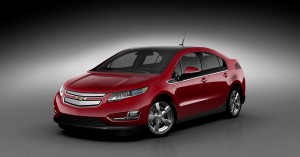
After owning a Honda Civic since 1998 that was new in 1998 – the only car that persisted in my household after my 2002 marriage to Jodi – Jodi and I decided last year to start saving for a new car. After checking out a Chevy Volt at the Texas States Fair, we made the decision that the Volt was at the top of our list. Since Chevy decided to mark down its 2013 Volts by $5000 to make way for their 2014 models, we made the decision last week to go look and, if it was in our budget, buy the car and trade in the Civic.
It fit in our budget, so now we’re the proud owners of an all-electric car that can be run either from energy stories in batteries or by a gas reserve (about 9 gallons). The vehicle switches seamlessly from batteries to gas. Right now, we get about 35 miles on a full charge. This is just under the amount of distance needed to make our daily round-trip commute to work at SMU.
Owning this vehicle has made me think about all the physics involved: energy density in batteries, the inductors used in “regenerative braking” (where slowing or braking the car converts mechanical energy back to the batteries to help lengthen their charge), the time required to charge the batteries, and, of course, the physics of the reduced cost to drive the vehicle.
I’ll focus on cost in this article, and leave some “questions for the student” at the end.
Energy Required to Charge the Batteries

We can plug the car into a standard U.S. 110 V outlet to charge. I have a Kill-A-Watt, a small device that can tell you how much energy is being used by the appliance(s) plugged into it. So I plugged that into the wall, then plugged the car into the Kill-A-Watt, so I can measure the energy required to charge the car. After several hours, I checked the device. It had registered 5.17 kWh of energy so far transferred from the wall to the car. The car batteries were 30% charged at this point, based on the information from my Android application (linked to the car).
So we can use a linear model (y=mx) and estimate how much energy is required to fully charge the car (and I can check this prediction in the morning, before it is fully charged). I estimate:
5.17 kWh * (100./30.) = 17 kWh
After the full charging cycle had nearly completed, I checked the Kill-A-Watt. It reported that just below 15 kWh had been used for the nearly full charge cycle, so my linear model over-predicts the energy usage a little. Our electricity cost is about 9.5 cents/kWh for us right now (on average across Texas). At 15 kWh to “refill the tank” (so to speak), this requires an expenditure of about $1.40.
Compared to a gas-powered 1998 Honda Civic
Our old Civic had an 11.5 gallon gas tank, and could get about 33 mpg (depending on the time of year – in the summer, it was more like 30 mpg). Since it takes about 35 miles to make the round-trip commute to work, we can compare the energy cost of operating the Civic on gasoline alone vs. the energy cost of operating the electric car on the same distance.
The number of gallons of gas needed to make the commute in the summer was 35 miles / (30 miles/gallon) = 1.17 gallons, or about 1.2 gallons. The cost of a gallon of gasoline right now in Texas in our area is about $3.40.
Comparison of the Commute Costs
So the cost to make that commute in the Civic was about $4.10 per day, whereas the cost of that commute in the Volt is about $1.4 per day. We’ve cut our per day work commute costs, in energy alone, down to just 34% of what they were a couple of weeks ago – a 66% savings.
Considering just the number of work commute days in a year – about 250 – that means we expect to save about $675 in the next year in energy costs alone, and that’s just on work commutes. Our gas tank needed to be filled about once every 7 days in the Civic, and if you do the math you can see that our commute used only about half of the gas we expended each week; the rest was on local shopping trips (evenings), or going out on weekends. However, on the weekends we tend to remain closer to home, well within the radius of a single charge of the batteries. So on the weekends and weeknights, all together, we were using another 6 gallons of gas (or thereabouts) each week. That’s another $19 or so eaten by gasoline in the Civic every week, which is now greatly reduced by the fact that we’re now able to do most of those short-range trips on batteries alone.
The bottom line is this: we used to spend about $2000/year on gas for the Civic. We expect the energy cost of the Volt to be closer to 40% of that, or about $800-$900 per year. I’m mostly curious to see how long we can drive this before we have to put gas back in the tank. In almost 5 days of owning it, we’ve used about 1 gallon of gas.
Question for the student
Here are some bonus physics questions.
- The Volt can be charged off of either a 110V socket or an upgraded 220V socket. What is the different in charging time between these two options, assuming a linear charging model?
Solution to the Questions
The Volt can be charged off of either a 110V socket or an upgraded 220V socket. What is the different in charging time between these two options, assuming a linear charging model?
This boils down to electrical power. The car/battery/cord charging assembly represents a large resistor, of value R. The wall outlet delivers a voltage, V. The power dissipated by the resistor (and, in this case, stored in the batteries) is given simply by P = V^2/R. If you double the voltage, from 110 V to 220 V, you expect the charging time to DECREASE BY A FACTOR OF 4, since power is energy per unit time and the voltage doubling means the power quadruples. In l linear model, the time to charge is a constant function (we know that’s not exactly a good model of the charging process from the above data, but this is close enough for our purposes!).
To test this, let’s let the data speak for itself. At 11am I pull the car into the garage. I am told by the car that if I charge with the normal voltage, the charging will be complete by 3am the next morning. If I use the “fast charger” (220 V), it will be complete by 3:15 pm on the same day. This time difference, in seconds, between 3:15pm and 11:00 am is 15,300 seconds; between 3am the next morning and 11am of this day it’s 57,600 s. That’s a time ratio of 57,600/15,300 = 3.7, or about a factor of 4.
Physics kicks ass.




2 thoughts on “The Physics of an Electric Car – Cost per Mile and Other Questions”
Thanks for posting this. Are you still heppy with the car and its cost of operation? Thank you
Yes, indeed! We are maybe putting gas in the car once a month. We took it on a holiday road trip last winter just to see how it handled long trips. Not only was it a great car for long trips (with still-excellent gas mileage), it got us through the Polar Vortex without a hitch.